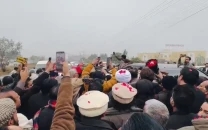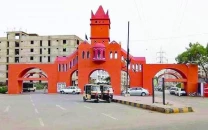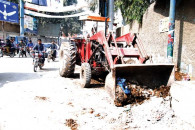PDF moot: Provinces go without blueprint
Only Sindh presents a detailed picture of how it proposes to cope with the task at hand at PDF moot.

The four federating units briefed over 300 delegates from all over the world about their priorities and achievements in the wake of the worst-ever floods in the history of the country.
Sindh, the most-affected, was the only province that was able to give a detailed picture of the losses and a plan to cope with the same in an effort to help over 7.2 million affected people.
Sindh Chief Minister Qaim Ali Shah told the participants that his province suffered a loss of $4.3 billion in the floods and needs up to $5 billion for reconstruction. “Sindh believes in self-reliance and it is going to impose flood surcharge on agriculture crops and residential and commercial plots in the urban areas,” said the CM.
“The provincial government has diverted over Rs40 billion funds from the available resources and would welcome foreign assistance primarily in irrigation, roads, municipal infrastructure, education and health,” said Adviser to Sindh CM Dr Kaiser Bengali.
The Punjab chief minister did not participate in the meeting under the pretext “of not feeling well” that raised many eyebrows. Punjab presented an overall strategy that was mainly focused on the achievements of the government over the past three years and did not table any project or plan for the donors’ consideration. However, it gave a briefing on ensuring transparency in using donors’ money. It also did not inform about its plans to raise additional money for flood-related reconstruction.
“The provinces took a general approach and were not sure how to deal with the aftermath of the floods. They probably did not have anything to sell,” said a delegate who had travelled from Washington to participate in the conference.
Although, Balochistan talked about the impact of floods in the province, it failed to present a reconstruction plan.
The Asian Development Bank country director for Pakistan Rune Stroem unveiled the Damage Needs Assessment Report. He said the floods have caused a total loss of $10.06 billion.
“The reconstruction cost ranges from $6.8 billion to $8.9 billion depending which option Pakistan adopts,” said Rune.
For building the same infrastructure which was destroyed in the floods Pakistan requires $6.8 billion. In order to build back better the requirement would surge to $7.4 billion and building back smarter needs $8.9 billion, he added.
Finance Minister Hafeez Shaikh has already unveiled a five-point strategy to arrange money for the reconstruction, which includes new taxes, reprioritisation of the budget, reprioritisation of donors’ loans, new loans from donors and pubic-private partnership projects.
A finance ministry official said that most of the donors have already told Pakistan that they would not be able to commit additional loans owing to their own compulsions.
According to the DNA report, social infrastructure suffered a loss of $1.95 billion, primarily in the housing sector which amounted to a loss of $1.59 billion. As much as $2.01 to $2.7 billion is required to rebuild the social infrastructure sector.
In the physical infrastructure sector the losses are assessed at $2 billion, and about $2.95 to $3.5 billion are needed for reconstruction.
The worst-hit sub-sector was transport and communication that suffered $1.4 billion losses and needs up to $2.5 billion for rehabilitation.
The largest affected was the economic sector which suffered a loss of $6 billion and within this sector the agriculture sector suffered $5 billion in losses.
Sindh was the most stricken province as it had to bear the loss of $4.4 billion and now needs up to $3.1 billion for reconstruction. Punjab, the second worst affected province, has to bear $2.6 billion in losses and requires up to $1.3 billion for reconstruction. Khyber-Pakthunkhwa suffered $1.2 billion in losses and requires up to $2.2 billion while Balochistan losses stood at $620 million and the maximum reconstruction cost is $684 million.
Published in The Express Tribune, November 15th, 2010.



















COMMENTS
Comments are moderated and generally will be posted if they are on-topic and not abusive.
For more information, please see our Comments FAQ